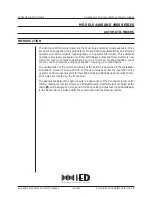
12
PRO MIXER NOX101
Quick Start Guide
13
PRO MIXER NOX101 Controls
(EN)
Step 2: Controls
(1)
PEAK LED
lights when the microphone
input signal clips. If this happens, lower the
MIC GAIN
knob.
(2)
MIC GAIN
knob adjusts the sensitivity of the
microphone input.
(3)
HIGH
and
LOW
knobs adjust the
microphone
EQ
.
(4)
CURVE
switch selects how gradually the
channel fader raises the volume, from an even
taper across the faders travel, to a steep jump
near the top of the fader track.
(5)
CHANNEL FADER
adjusts the
channel’s volume.
(6)
CHANNEL EQ
knobs adjust the
HIGH, MID,
and
LOW
frequencies of the channel.
(7)
POWER LED
lights when the mixer is
powered on.
(8)
METER
button selects whether the
VU METERS
display the main or
PFL
signal level.
(9)
REV LED
lights when the
REV
button
is engaged.
(10)
CHANNEL GAIN
knob adjusts the sensitivity
of the channel inputs.
(11)
MASTER
knob adjusts the output of the
MAIN
OUTPUTS.
(12)
MIC LEVEL
knob adjusts the microphone
volume.
(13)
CUE GAIN
knob adjusts the level of the cue
(headphone) signal.
(14)
VU METER
displays the main stereo signal
when the
METER
button is set to
MAIN
,
and displays the channel 1 and 2 signals
when set to
PFL
.
(15)
CUE FADER
blends the content of the cue
signal between channel 1 and channel 2
for headphone monitoring.
(16)
PHONO/LINE
switch selects either the
PHONO
or
LINE
inputs as the channel’s
audio source.
(17)
CROSSFADER
fades between channel 1
and channel 2.
(18)
XFADE CURVE
knob determines how steep or
gradual the fade between channel 1 and 2 is.
(19)
REV
button switches the position of channel 1
and 2 on the
CROSSFADER
.
(20)
PHONE/LINE
button optimizes the
PHONO
inputs for use with a turntable or
line-level source.
(21)
POWER
switch turns the power on and off.
(1)
El
LED PEAK
se ilumina cuando se conecta
la señal de entrada del micrófono. Si esto
sucede, disminuya la perilla
MIC GAIN
(Ganancia del micrófono).
(2)
La perilla
MIC GAIN
ajusta la sensibilidad de la
entrada del micrófono.
(3)
Las perillas
HIGH
y
LOW
ajustan el
EQ
(Ecualizador)
del micrófono.
(4)
El interruptor
CURVE
selecciona cómo el
atenuador del canal incrementa gradualmente
el volumen, desde una reducción uniforme a
través del viaje de los atenuadores, hasta un
salto agudo cerca de la parte superior de la
pista del atenuador.
(5)
CHANNEL FADER
(Atenuador de canal) ajusta
el volumen del canal.
(6)
Las perillas
CHANNEL EQ
ajustan las
frecuencias
HIGH (ALTA), MID (MEDIA),
y
LOW (BAJA)
del canal.
(7)
El
POWER LED
se ilumina cuando el
mezclador se enciende.
(8)
El botón
METER
selecciona si los
MEDIDORES
VU (VU METERS)
despliegan el nivel de señal
principal o
PFL
.
(9)
El
REV LED
se ilumina cuando se activa
el botón
REV
.
(10)
La perilla
CHANNEL GAIN
ajusta la
sensibilidad de las entradas del canal.
(11)
La perilla
MASTER
ajusta la salida de las
MAIN OUTPUTS
(SALIDAS PRINCIPALES).
(12)
La perilla
MIC LEVEL
ajusta el volumen
del micrófono.
(13)
La perilla
CUE GAIN
ajusta el nivel de la señal
cue (audífonos).
(14)
El
MEDIDOR VU
despliega la señal estéreo
principal cuando el botón
METER
está
ajustado en MAIN, y despliega las señales de
los canales 1 y 2 cuando se ajusta a
PFL.
(15)
CUE FADER
mezcla el contenido de la
señal cue entre el canal 1 y el canal 2 para
monitoreo de audífonos.
(16)
El interruptor
PHONO/LINE
selecciona ya sea
las entradas
PHONO o LINE
como la fuente de
audio del canal.
(17)
CROSSFADER
(atenuador cruzado) atenúa
entre el canal 1 y el canal 2.
(18)
La perilla
XFADE CURVE
determina qué tan
elevada o gradual es la atenuación entre el
canal 1 y 2.
(19)
El botón
REV
cambia la posición del
canal 1 y 2 en
CROSSFADER
.
(20)
El botón
PHONE/LINE
optimiza las entradas
PHONO
para ser usadas con una tornamesa o
fuente de nivel de línea.
(21)
El interruptor
POWER
enciende y apaga
la energía.
(ES)
Paso 2: Controles
Summary of Contents for Pro Mixer Nox101
Page 14: ...We Hear You...
































